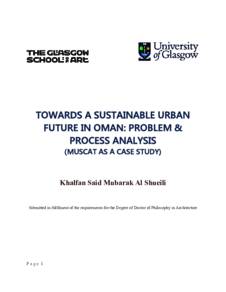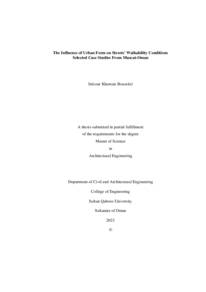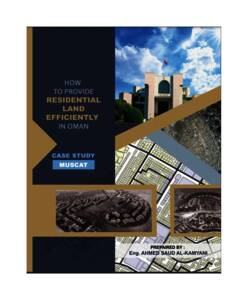Document
Towards a sustainable urban future in Oman : problem & process analysis (Muscat as a case study).
Publisher
University of Glasgow.
Gregorian
2015
Language
English
English abstract
Like its neighbouring countries, Oman has witnessed an extraordinary social and economic
development over the past few decades. This was mainly one-sided socio-economic development
dependent on the oil sector and the government has continuously strived to draw a balance
between exploitation of its natural resources, and the development program which indicates an
early courtesy towards sustainability and environmental protection. The pressure towards
massive investment in development and economic progress was nevertheless higher and
determined to a large extent its success in maintaining this equilibrium. As such, one has to
address this important issue within the framework of urban sustainability. The essence of this
thesis contribution to knowledge lies around the dissection of the decision making process
around urban planning and development in Oman during the past forty years (through problem
and process analysis) and how it may be directed towards a more sustainable urban future.
The aims of this research are: to develop a comprehensive understanding of the history of urban
development in Oman since 1970, and to provide insights into the decision making processes
which have occurred during this period; to develop an understanding of contemporary decision
making processes in urban planning, including an understanding of decision makers and citizens
attitudes towards urban sustainability; to identify problems and successes in these areas; and to
develop an improved strategy for urban planning that will provide an effective and equitable
sustainable urban future.
The study has progressed in a sequence of phases: identifying the main dimensions of urban
sustainability that are relevant for this study; mapping out the history of urban development
planning, including its main objectives, policies, urban development milestones and challenges;
carrying out the research using a triangulated methodology approach that consists of: historical
analysis of milestones and projects within the development of town planning in Oman over the
past forty years, semi-structured interviews of decision makers, and the assessment of behaviour
and attitudes of the general public towards sustainability through the use of focus groups and
Page 4
questionnaires. This has revolved around a few case studies of existing districts from Muscat, the
capital of Oman.
The framework for this study consisted of 16 urban sustainability dimensions (USDs), which can
be looked at as the agenda for any serious review of urban sustainability specific to Oman. The
problem analysis phase produced a list of problems, challenges, constraints and drivers that can
be utilized in addressing the progress of urban development and how it may be enhanced in the
future. It was evident that throughout the early years of development, and up to 1995, Oman has
undertaken serious strategy development across various disciplines within urban development.
As a result of the process analysis phase, there is an apparent gap between strategy development
and implementation, and this research identified 14 strategy shortcomings and 24
implementation shortcomings. As an outcome of this analysis, the research identifies a
comprehensive list of recommendations against each urban sustainability dimension and this
should aid any consultant that aims to develop future urban planning strategies, and the
professionals entrusted with implementation of such strategies.
It is not surprising that focus should be cast on land use, urban planning and urban transport. The
plot distribution system in Oman has driven our cities to the shape they are in today, and has
affected other elements of the city in this route, such as transport corridors, urban design and
urban quality. The lack of a meaningful urban development management at a city scale
contributes to this dilemma, but there are solutions to overcome this that should be looked at.
This research could be carried forward by translating these urban sustainability dimensions into
indicators which will be able to measure progress and success against the government actions
and other initiatives addressing sustainability. In addition, the product analysis phase that would
involve case studies within Muscat as a city could be undertaken to identify the association of the
outcome with the strategies developed and their implementation. In addition, the results within
this research could be tested against the current progress and development of Oman National
Spatial Strategy, under development since 2008. The qualitative analysis in this research would
be enhanced by conducting quantitative analysis into the decision making process and to
measure the gap behind strategy and implementation.
Member of
Resource URL
Category
Theses and Dissertations



